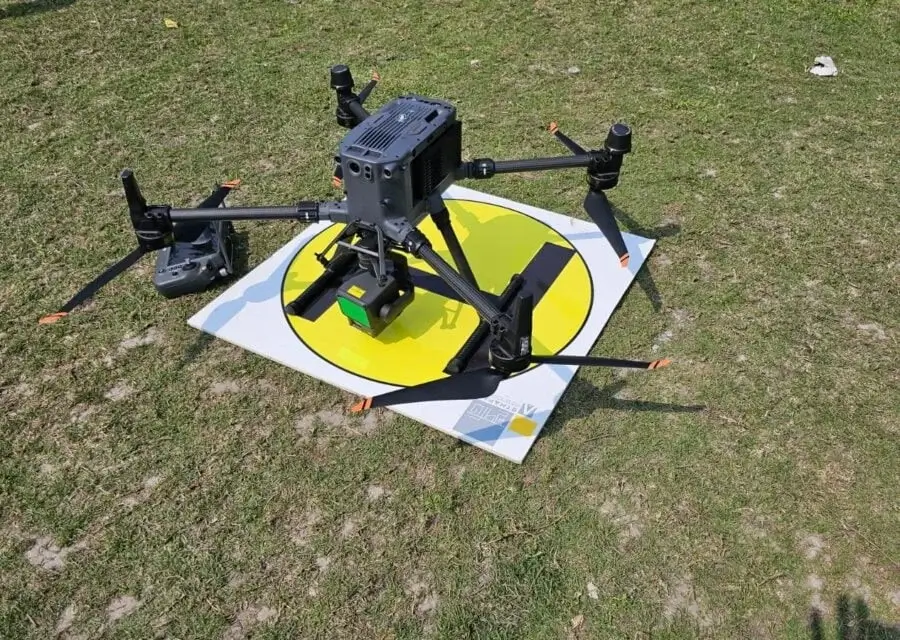What is Drone Surveying?
Drone surveying refers to the process of using drones to collect, analyse, and create maps of a specific area or location. Through drone surveys, rapid and accurate data is collected regarding land, infrastructure, water bodies, canals, forests, or other environmental areas. This data can be in the form of images, videos, or sensor data, which is later used for analysis and mapping using various software.
During a drone survey, the drone, equipped with cameras and sensors, captures high-resolution images, videos, or three-dimensional (3D) data. The exact position is determined with the help of GPS and other geospatial technologies. It is a method that is faster and much more accurate compared to manual surveying.
Benefits of Drone Surveying:
- Speed: Drones can collect data over large areas very quickly.
- Accuracy: Data collected through drones is highly precise and effective for mapping.
- Access to difficult areas: Drones can easily operate in remote and dangerous areas where it is difficult for humans to reach.
- Cost-effective: Compared to traditional surveying methods, drone surveys are completed at a relatively lower cost.
- 3D Mapping: The data collected by drones can be used to create three-dimensional maps, which assist in advanced analysis.
Drone surveying is currently being used in land surveying, urban planning, infrastructure development, agriculture, forestry, monitoring of canals and waterways, and various environmental studies.
The Role and Importance of Drone Surveys Before Starting a New Project
Drone surveys play a crucial role before starting a new project. By using drones, rapid and accurate data can be collected, which is essential for project planning, design, and implementation. Through drone surveys, critical information about land, infrastructure, water bodies, environmental conditions, and other relevant data is gathered, ensuring the accuracy and sustainability of the project.
Below are the roles and importance of drone surveys:
1. Rapid and Accurate Data Collection
Drone surveys can capture high-resolution images and videos over large areas in a short time. This facilitates faster and more precise data collection during preliminary surveys, helping in the correct planning of the project’s next stages.
2. Creation of 3D Maps and Models
Data collected from drones can be used to create three-dimensional (3D) maps, which assist in spatial analysis of the project area and future planning. These models are particularly useful for land development, road construction, and other infrastructure projects.
3. Environmental Analysis
Drones make it easier to analyse the environmental impact in the project area. Using sensors and cameras, drones can measure the quality of water, air, and soil, helping to determine the potential environmental effects of the project.
4. Assessment of Damage and Risks
Drone surveys are highly effective for analysing soil erosion, land changes, or the risk of future damages in the project area. This helps in planning maintenance strategies early on in the project.
5. Site Security and Monitoring
Ensuring site security before a project starts is a major challenge. Drone surveys help in monitoring and securing the site, identifying potential hazards and preventing unwanted accidents.
6. Cost and Time Management
Traditional methods of gathering site information are time-consuming and expensive. Drone surveys solve this issue by completing survey tasks faster and at a lower cost, increasing the likelihood of meeting project deadlines.
7. Monitoring Project Progress
After a project begins, drone surveys help in regularly monitoring the site’s progress. It’s an effective way to manage the project and verify its advancement.
8. Reducing Complexity and Risk
Drone surveys can easily operate in remote and hazardous areas, where human intervention is risky. This helps in reducing complexity and risk in the project.
Summary:
Using drone surveys before starting a new project plays an effective role in project planning, environmental analysis, and successful implementation. It is not only cost and time-saving but also reduces project risks and aids in informed decision-making.
The Role of Drone Surveys for Large Plots
The role of drones in surveying large plots is extremely important and effective. Using drones, large land plots or areas can be surveyed quickly, accurately, and cost-effectively, making it a superior method compared to traditional approaches. Below are the key roles of drone surveys for large plots:
- Fast and Accurate Surveying
Drones enable rapid and precise surveying of large areas. High-resolution images and videos captured by drones can be analysed through software to create an accurate map of the plot. This is especially important for large plots, where manual surveying can be time-consuming and labour-intensive. - Boundary and Area Determination
Drone surveys help in accurately determining the boundaries of large plots of land. This is crucial for resolving land ownership disputes and ensuring clear boundary demarcation, which is vital for large-scale plots. - Creation of 3D Maps
Using data collected from drones, 3D maps of large plots can be created. These maps provide detailed insights into land elevation, slopes, and other geographical features, which are useful for construction, agricultural management, and land development. - Cost and Time Efficiency
Manual surveys of large plots can be expensive and time-consuming. Drone usage reduces the time needed for surveying large plots and significantly cuts costs, making it particularly beneficial for agricultural, construction, and land development projects. - Surveying Remote and Hazardous Areas
Large plots often include remote or hazardous areas that are difficult to access. Drones can easily survey such areas, reducing the need for human presence and lowering the risk involved in the survey. - Environmental and Land Analysis
Drones can monitor the environmental impact, soil erosion, water reservoirs, and air flow over large plots of land. Sensors and cameras equipped on drones make it easy to gather data for environmental analysis and efficient land management. - Regular Monitoring and Development Assessment
Drones can be used to regularly monitor the condition of large plots. During development projects, drones are highly effective in assessing project progress, allowing for rapid evaluation of ongoing work.
Summary:
Drone surveys provide fast, accurate, and cost-effective solutions for large plots. With drones, determining precise boundaries, creating 3D maps, conducting environmental analysis, and monitoring development becomes easier. This leads to improved efficiency, reduced costs, and enhanced quality in survey operations.

The Role of Drones in Surveying and Mapping
Architects can use drone mapping technology to create detailed 3D models of buildings before construction. Using drones for mapping offers many advantages over traditional methods such as satellite imagery or ground-based surveys. With cameras attached to drones, it is possible to capture precise images of specific areas. Drones are now widely used for surveys in various infrastructure projects. For example, commercial factories, mountainous roads, bridges, and dams can be easily mapped by flying drones over the entire plot before construction.
Environmental Monitoring: Drones assist in monitoring environmental changes such as deforestation, coastal erosion, and wildlife habitats. They provide essential data for conservation efforts and sustainable land management.
Aerial Photography and Videography: Drones can capture high-resolution images and videos from various heights and angles, providing detailed visual data for mapping and analysis.
Equipped with Light Detection and Ranging (LiDAR) sensors, drones can create precise 3D models of terrain, capturing elevation data and surface details. By capturing detailed elevation data, drones can produce accurate topographic maps, which are useful for construction planning, land development, and environmental studies.
In summary, drones offer a fast, precise, and cost-effective solution for surveying and mapping, providing essential data for various industries and projects.
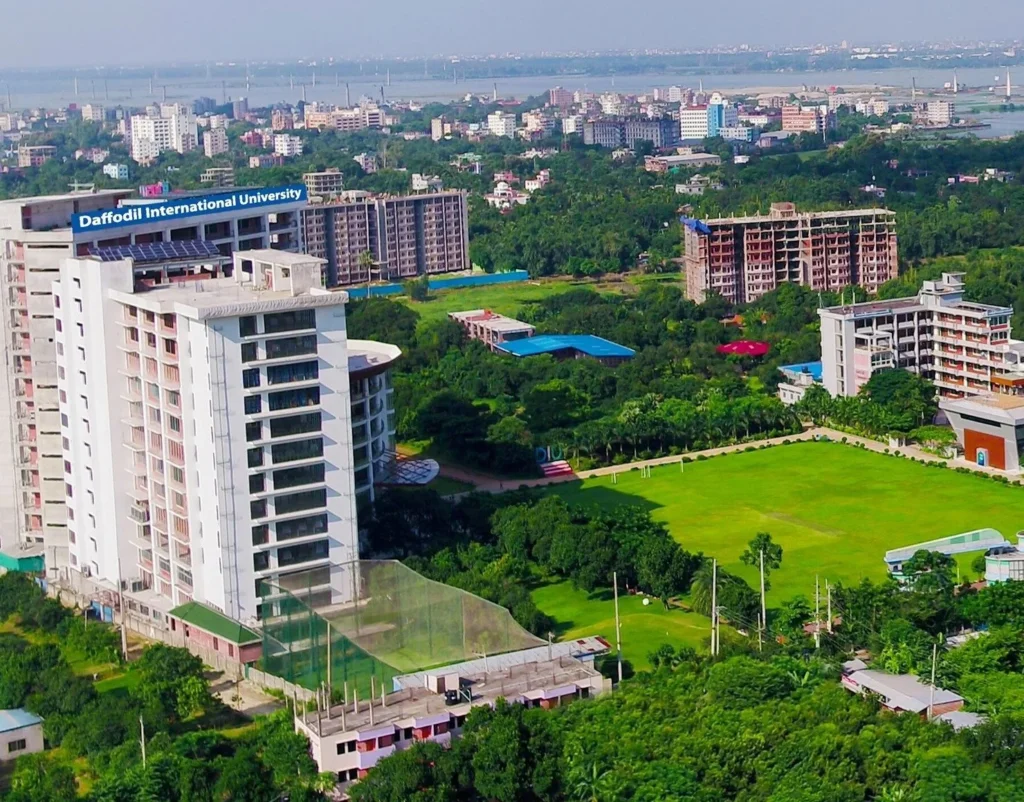
Role of Drone Surveys in Urban Planning and Infrastructure Development
Drones can create 3D models of landscapes, buildings, and infrastructure, which assist in urban planning, disaster management, and the preservation of historical sites. Drones can cover large areas faster and more cost-effectively compared to traditional manned aerial surveys or ground-based methods.
Drones can easily access hard-to-reach or hazardous areas, such as mountains, forests, and disaster zones, without risking human safety. They allow for frequent and repeatable data collection, enabling up-to-date monitoring of changes in environments, urban development, and agriculture. Drones help with urban planning, infrastructure development, and traffic management. Drone mapping is widely used for land surveys and precise topographic map creation. It assists professionals in construction, engineering, and land development to assess terrain, plan infrastructure projects, and define property boundaries.
Below are the various roles of drone surveys in urban planning and infrastructure development:
- Rapid and Accurate Data Collection:
Drones can capture high-resolution images and videos of different parts of a city from above. This provides rapid and accurate data, which helps create precise maps of the city. Accurate and up-to-date data is essential for proper city planning and building construction. - Creation of 3D Models and Maps:
The data collected by drones can be used to create three-dimensional (3D) maps and models of the city. These models help in analysing the height, shape, and geographical features of different areas, which are crucial for building construction and infrastructure development. - Saving Time and Costs:
Using drones to survey large urban areas is faster and more cost-effective. Where traditional methods require significant time and expenses, drones can collect data efficiently, making the process much more economical in terms of both time and cost. - Accurate Planning for Infrastructure Development:
Information gathered through drones helps in precise planning for infrastructure development, such as roads, water supply, electricity, and drainage systems. Drone surveys provide vital information that enhances the quality and effectiveness of development projects. - Monitoring Roads and Transportation Systems:
Drone surveys play a significant role in monitoring and planning road and transportation systems in cities. The condition of roads, traffic congestion, and vehicle movement can be easily observed through drones, aiding in better city traffic planning and road development. - Environmental Analysis:
Drone surveys are essential in analysing the environmental impact of urban development projects. With drones, the air, water, and soil quality in a city can be monitored, helping in identifying environmental risks and taking appropriate action. - Regular Monitoring and Development Observation:
During urban development projects, drones can be used to monitor the site’s status regularly. This helps in evaluating the progress of the project and quickly resolving any issues that arise.
Summary:
Drone survey technology provides rapid, accurate, and cost-effective solutions for urban planning and infrastructure development. Through this, it is possible to make the city’s planning, environmental analysis, and infrastructure development activities more precise and efficient, playing a crucial role in the city’s future development.

Effectiveness of Drone Survey
A drone survey is a modern method that uses drones, or unmanned aerial vehicles (UAVs), to collect images and data from above. This technology is highly effective for quickly and accurately mapping large areas, offering significant advantages over traditional land surveying methods. Equipped with high-resolution cameras and sensors, drones fly over survey sites, capturing hundreds of images and gathering data that can be processed to create detailed maps, 3D models, and other important information. Drones are particularly effective in areas that are difficult or dangerous for humans to access.
Drones can survey challenging and hazardous locations, such as mountainous regions, forests, and disaster zones, more safely and efficiently than manual methods. Additionally, drone surveys can be completed much faster and at a lower cost. Where traditional survey methods can be time-consuming and expensive, drone technology simplifies the process, saving both time and money.
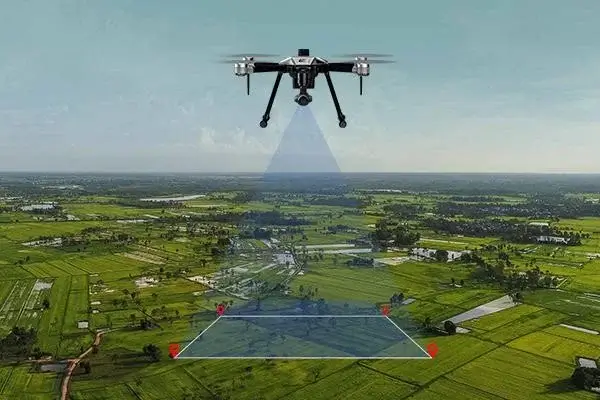
The Key Role of Drone Surveys in Project Management
Drone surveys play a significant role in project management, particularly in surveying areas that are difficult or dangerous for humans to access, such as construction sites, large fields, forests, or coastal regions. By utilizing drones, surveyors can save both time and cost while increasing the accuracy and safety of their work. As a result, drone surveys have become an essential tool across various industries, including construction, agriculture, mining, and environmental monitoring. They aid in planning, decision-making, and overall project management.
The Department of Land Records and Surveys has already begun conducting experimental drone surveys. After testing at Kuakata Sea Beach, a company was awarded a tender by the honourable Secretary of the Ministry of Land to carry out a drone survey in the Itabaria mouza of Sadar Upazila, Patuakhali. Once the company completes the survey, the Department will conduct a final evaluation, and the survey work will be extended to Sadar Upazila in Patuakhali and Barguna.
Using drones, high-resolution images and videos of project areas can be captured quickly, which saves significant time compared to traditional methods. One of the major advantages of drone surveys is their ability to provide accurate data essential for planning and developing projects. Drones can also survey remote, dangerous, or challenging locations more safely than manual surveys. This increases site safety and reduces risks during the project, as drones can identify hazardous areas in advance, allowing appropriate safety measures to be taken.
Drone surveys are completed more quickly and at a lower cost than conventional methods. In traditional surveys, significant time and labor are required, but drones make data collection faster and more efficient, ultimately reducing project expenses.
Summary:
Drone surveys play a crucial role in project management by increasing time efficiency, reducing costs, and improving effectiveness. They simplify rapid and accurate data collection, risk management, and project progress monitoring. The use of drones ensures project accuracy and success, making them indispensable for advanced project management as a whole.
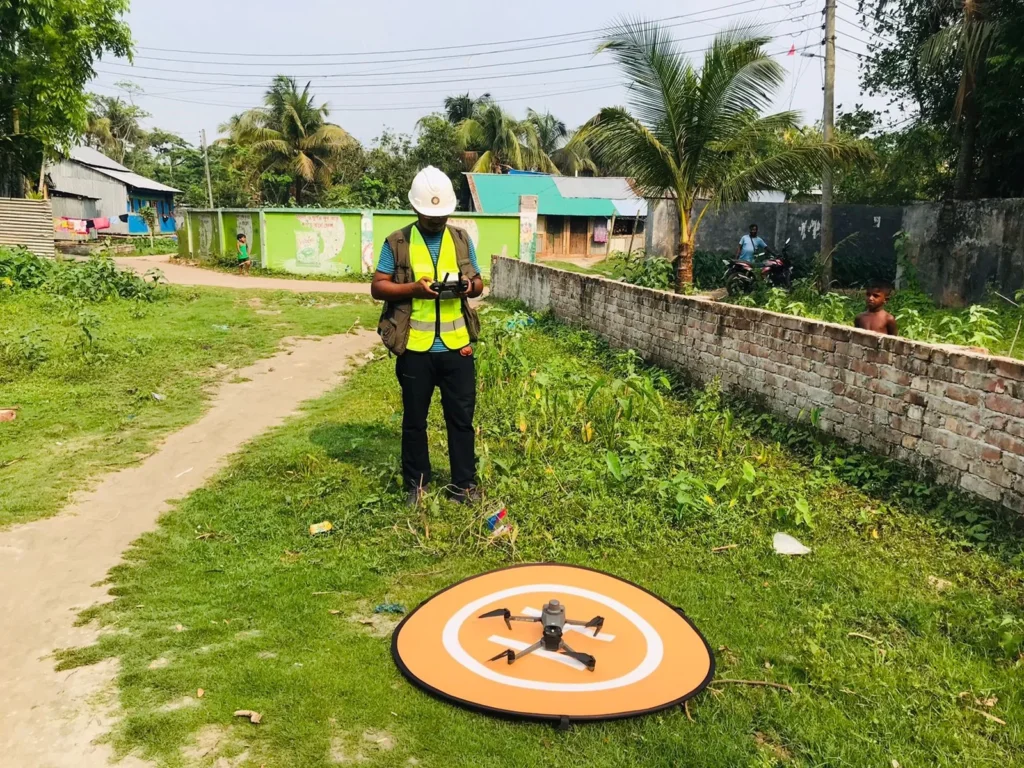
The Use of Drone Surveying for Large Areas
Drones have become an essential tool for surveying large areas, enhancing communication among construction participants, improving site safety, and enabling the precise topographic measurement of expansive regions. Through the principles of aerial photogrammetry, drones can conduct surveys for buildings, bridges, roads, highways, and industrial construction projects.
Survey drones create high-resolution Ortho mosaics and detailed 3D models in areas where low-quality, outdated, or even no data are available. They allow for the swift and easy creation of highly accurate cadastral maps, even in complex or hard-to-access environments. Drone solutions gather precise, geo-tagged data quickly, which photogrammetry software processes to deliver standardised outputs.
Key Uses of Drone Surveys for Large Areas:
- Rapid and Precise Data Collection
Drones are highly effective for surveying large areas such as agricultural lands, forests, coastal zones, or industrial regions. They fly quickly over large spaces, capturing high-resolution images and videos, delivering accurate and timely data much faster than traditional methods. - Project Monitoring and Development
Drones facilitate easy monitoring of construction projects, infrastructure development, and environmental changes. In large-scale areas, drone surveys assist in tracking project progress and supporting future planning. - Creation of 3D Maps and Models
The data collected through drones can be used to create 3D maps of large areas. These models help analyse land elevation, slopes, and other geographical features, making it easier to plan and develop the area effectively. - Environmental Monitoring
Drones can monitor extensive areas to assess environmental conditions, such as deforestation, riverbank erosion, or the effects of climate change. Timely data collection through drones allows for continuous monitoring and helps take corrective action. - Emergency Management
In emergency situations like floods, fires, or earthquakes, drone surveys are extremely useful. Drones can quickly assess affected areas and provide necessary information, aiding rescue operations and risk management.
Conclusion:
Drone surveying offers a quick and cost-effective solution for surveying large areas, providing accurate data that saves time and money. Drones make it easier to monitor environmental changes, manage construction projects, and assess large regions efficiently, supporting improved planning and management.
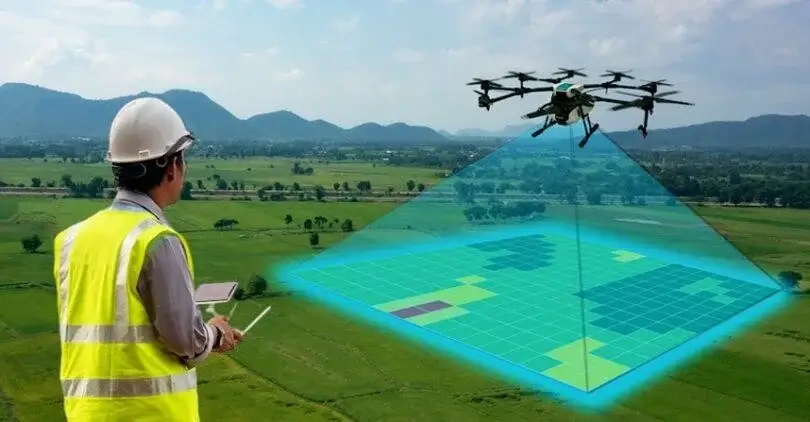
The use of drones for digital mapping of land has begun, providing accurate information.
According to Haryana Revenue Department’s ACS (Additional Chief Secretary), P.K. Das, the digital mapping of land properties will be created using drones, and then connected with GPS. The process of digital mapping using drones has already started. As the propellers spin, they push air molecules downward, lifting the drone upwards. Once in the air, the drone can move forward, backward, left, or right by adjusting the speed of each of the four propellers. By collecting multiple data points, it will be possible to gather accurate information about land size, including features like trees, ponds, buildings, semi-open structures, and tin-roofed houses.
Benefits of Drone-Assisted Digital Land Mapping:
- Accurate Information Collection
Drone surveys provide precise data on the shape, boundaries, and geographical features of the land. This helps in accurately determining the size and boundaries of land, which is crucial for resolving ownership and boundary disputes. - Fast and Efficient Surveying
Drones can quickly capture high-resolution images and videos of large areas. This is much faster and more efficient than traditional manual surveys, saving both time and cost. - Creation of 3D Models
Using data collected by drones, three-dimensional (3D) maps of the land can be created. These models are useful for construction, project planning, and development, as they provide insights into the land’s elevation, slopes, and other topographical features. - Surveying Challenging or Dangerous Areas
Drones can easily survey areas that are difficult or dangerous for people to reach, such as rugged terrain, forests, or regions affected by natural disasters like floods. - Cost-Effective
Digital land mapping with drones allows for the collection of more data at a lower cost. In contrast to traditional methods that require extensive labour and expense, drone surveys are faster and more cost-efficient.
Summary:
Using drones for digital mapping of land has made it easier to obtain accurate data. This method supports land development, construction planning, and boundary determination, aiding in effective decision-making and accelerating developmental activities.
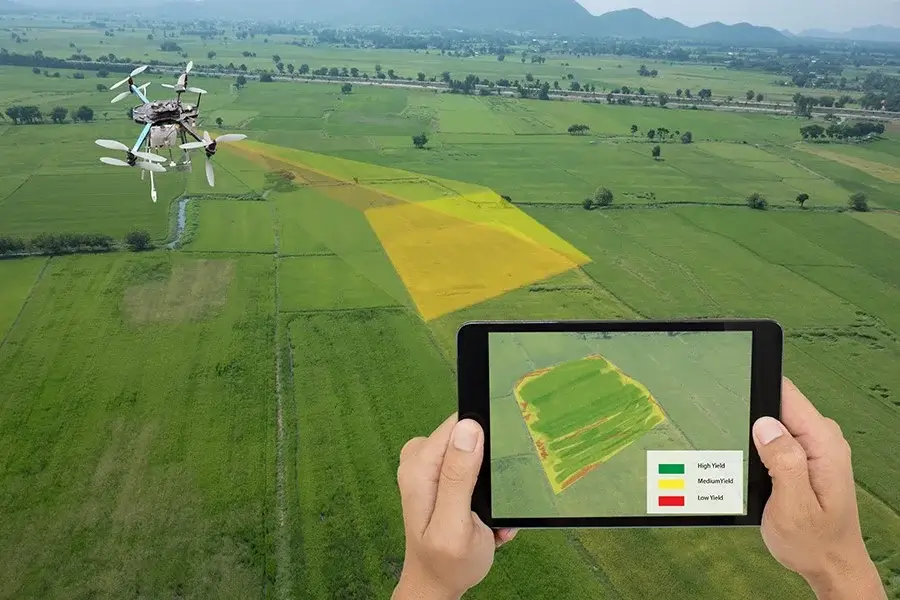
How Drones Assist in Conducting Topographic Surveys
Drones can create 1:500 scale maps without using Ground Control Points (GCPs) while meeting the requirements for centimetre-level accuracy. They can enhance the efficiency of data collection and processing by up to ten times, achieving faster deliverables and shortening the project lifecycle. You can obtain industry-standard outputs such as Digital Orthophoto Maps (DOM), Digital Surface Models (DSM), 3D reality models, and much more. Small teams can operate multiple drones using a single remote controller to quickly cover large areas.
Topographic surveys conducted via drones are also helpful for monitoring environmental changes such as land use changes, deforestation, river erosion, etc. Using data collected by drones, three-dimensional (3D) models can be created. These models are extremely useful for understanding the complexities of the terrain, playing an effective role in project planning and construction. Drones are capable of flying quickly over large areas and capturing high-resolution images and videos, making them much faster compared to traditional manual surveys, thereby saving both time and costs.
Drones serve as a modern, rapid, and effective technology for topographic surveys, assisting in the collection and analysis of accurate information. Consequently, they provide significant advantages in project planning and development.
- Drone Survey Accuracy and Limitations
Achieving accurate results in drone surveys relies heavily on understanding factors that affect the accuracy of your data, including ground sample distance, camera resolution, and flight altitude. The type of drone, camera resolution, and flight height all influence the accuracy of your survey. For instance, high-end surveying drones like the Wingtra One can achieve precision up to 1 cm (0.4 inches) under ideal conditions. You also need to consider vegetation, geolocation technology, weather, and restricted areas, as these can affect your outcomes. When processing images with photogrammetry software, you can extract information such as distances and volumetric measurements to create detailed 2D and 3D maps. However, this method may not be suitable for small-scale projects or inclement weather conditions. It is crucial to understand the difference between absolute accuracy (comparing your maps to real landscapes) and relative accuracy (ensuring consistency within your maps).
The accuracy and limitations of drone survey technology play a significant role in data collection. Let’s discuss these two aspects:
Accuracy:
- High Resolution: Drones use high-resolution cameras and sensors that can capture clearer and more detailed images. As a result, the accuracy of information increases when creating maps.
- Modelling Capabilities: Data collected via drones can be utilised to create three-dimensional (3D) models, which assist in analysing the complexities of the geography.
- Geo-Referencing: Drone surveys typically employ GPS technology, which ensures accurate positioning and measurements. This, in turn, enhances precision in location identification.
- Real-Time Data Collection: Drones can collect data quickly, providing accurate and updated information for subsequent processing.
Limitations:
- Battery Life: The limited battery life of drones can impede long-duration data collection, particularly when surveying large areas.
- Influence of Atmospheric Conditions: Weather factors such as rainfall, temperature, and wind speed can impact the effectiveness of drones. Adverse weather can lead to delays in survey schedules.
- Variety of Terrain: Certain types of terrain, such as dense forests or mountainous areas, can pose challenges for drones, potentially reducing the efficiency of data collection.
- Technical Limitations: The technical limitations of drones, such as sensor capabilities and flight altitude, can sometimes hinder the accurate collection of information.
- Legal and Regulatory Constraints: There are legal and regulatory limitations regarding drone usage in some countries that may affect survey operations.
Summary:
Drone survey technology represents a modern method for collecting accurate data; however, its limitations are also significant. Technological advancements and proper planning are necessary to enhance accuracy and address limitations.
Do Drones Provide Environmental Information?
Drones can collect information on environmental factors such as air quality, noise levels, and soil erosion. This information helps professionals make informed decisions regarding construction practices and minimises the impact on the surrounding environment. Drones have revolutionised the survey process by providing accurate data, enhancing safety, and improving overall efficiency in construction and civil engineering projects. Drones are highly effective tools for gathering environmental data. They are equipped with high-tech cameras, sensors, and other equipment that can provide detailed information about various environmental changes and conditions. Below are some key areas where drones provide environmental information:
- Monitoring Land Use: Drones can be used to monitor changes in land use in agricultural, forestry, and urban areas. This provides important information on how land use is changing and its impact.
- Observing Deforestation: Drones can monitor forest areas, providing accurate information on the process of deforestation, its causes, and its effects.
- Analysing Climate Change: Drones can be used to observe the impacts of climate change, such as temperature, precipitation, and other climate-related changes.
- Monitoring Natural Disasters: Drones assist in assessing damage and conditions during natural disasters such as floods, earthquakes, or wildfires.
- Water Conservation: Drones are used to monitor reservoirs and rivers, aiding in the management of changes in water levels and water resources.
- Testing Air and Environmental Quality: Drones are used to monitor air quality and pollution, which generally affects human health and the environment.
- Biodiversity Assessment: Drones can be used to monitor the location and numbers of various animals and plants, providing insights into natural biodiversity.
Summary
Drones represent a cutting-edge and effective method for collecting environmental information, playing a crucial role in scientific research, policy-making, and natural resource management. They are capable of gathering data quickly, affordably, and safely, helping to understand environmental conditions and support informed decision-making.
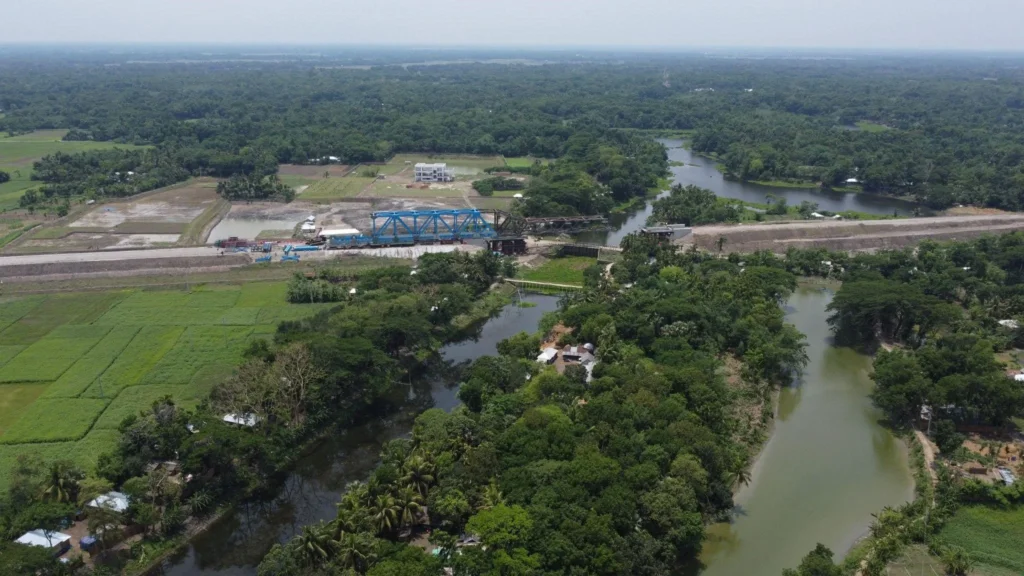
The Role of Drones in Canal Surveying
The role of drones in canal surveying is highly effective and innovative. The use of drones provides numerous advantages in creating accurate maps, analysing, and monitoring canals and other waterways. The key roles and benefits of drones in canal surveying are as follows:
1. Rapid and Accurate Data Collection
Drones can fly over canals quickly and capture various high-resolution images and videos with precision. This helps in swiftly analysing the canal’s length, width, depth, and the characteristics of the surrounding land.
2. Access to Remote and Hazardous Areas
Many canals are located in areas that are difficult or dangerous for manual surveying. Drones can easily access such places, where manual equipment or human presence may be risky, such as muddy canals or narrow waterways.
3. 3D Mapping and Model Creation
Using the images and data collected by drones, three-dimensional (3D) models of the canal can be created. These models allow detailed analysis of the canal’s depth, flow direction, bends, and the surrounding land.
4. Monitoring of Flow and Water Management
Drones can regularly monitor the flow of the canal, water levels, and the conditions of nearby flooded areas. This plays a significant role in water management and canal maintenance.
5. Monitoring Terrain and Changes
Drones can easily observe changes in the land surrounding the canal, such as landslides or riverbank erosion. If any changes occur near the canal, drones can quickly capture them, and the data can be analysed.
6. Canal Maintenance and Inspection
Drones make it easier to monitor the condition of canals and identify maintenance needs. For example, drones can help determine if a canal is blocked, if aquatic plants have overgrown, or if any damage has occurred.
7. Measuring Canal Depth and Analysing Water Flow
Drones can be used to measure water levels and flow in canals, especially using LIDAR or SONAR technology. This helps in determining the canal’s depth, soil deposition, and the exact amount of water flow.
8. Environmental Impact Analysis
The environmental condition of the canal and its surroundings can be analysed through drones. Using high-resolution images and sensors, drones can assess water quality, pollution, and the impact on aquatic plants or animals in the canal.
9. Data Analysis and Reporting
Data collected from drones can be easily analysed and reports can be generated through various software. These reports provide valuable information for canal development or maintenance.
Summary:
Drones collect data quickly, accurately, and cost-effectively in canal surveys. They make it easier to analyse the canal’s condition, perform maintenance, and monitor environmental impacts, thereby improving the overall canal management process.
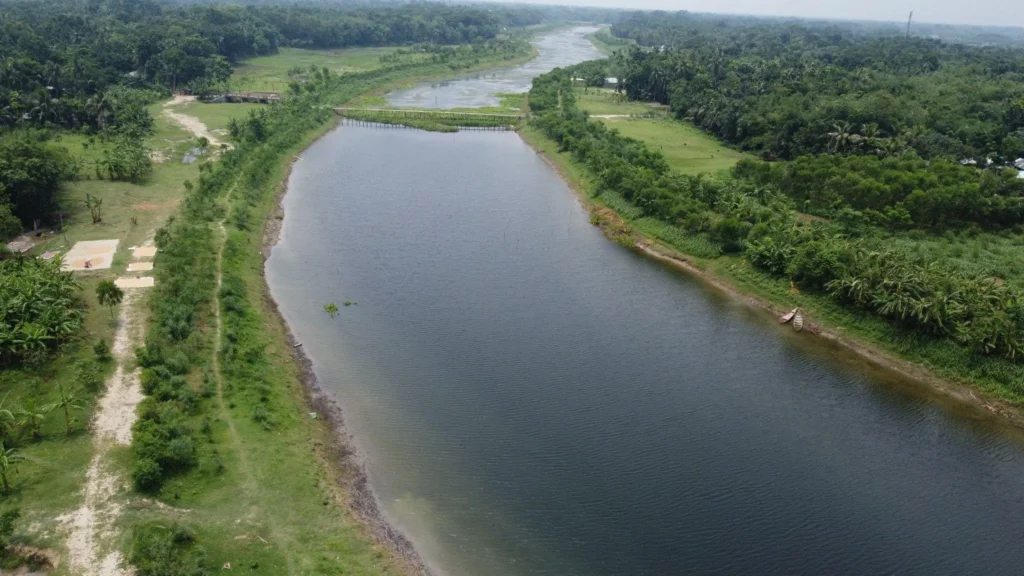
The Role of Drones in River Surveys
Drones play a highly effective and technologically advanced role in river surveys. Through the use of drones, the depth, width, flow, and surrounding geographical conditions of a river can be observed quickly and accurately. Drones are particularly useful for analysing the river’s condition, maintaining it, and determining the environmental impact. Below are some key roles of drones in river surveys:
1. Fast and Accurate Data Collection
Drones can quickly and accurately fly over rivers to capture high-resolution images and videos. This helps in analysing the river’s width, depth, flow direction, and the condition of nearby land.
2. Access to Remote Areas
Some parts of rivers are located in areas where human presence or the use of equipment can be risky. Drones can easily access such areas where manual surveys might be difficult.
3. Creation of 3D Maps and Models
Data collected by drones can be used to create three-dimensional (3D) models of rivers. These models are helpful for analysing the river’s depth, bank changes, flow direction, and bends.
4. Regular Monitoring and Flow Analysis
Drones can regularly monitor the river’s flow, water levels, and flooded areas. This is highly effective in flood prevention and water management.
5. Water and Environmental Analysis
Drones can analyse the quality of river water, pollution levels, and the condition of biodiversity connected to the river. By using sensors and cameras, monitoring the water condition becomes easier.
6. Monitoring Changes to Riverbanks
Riverbank erosion, land shifts, and changes can be easily observed through drones. This helps in taking preventive measures against future damages.
7. River Maintenance and Repair Monitoring
Drones can determine the maintenance and repair needs of rivers. If any damage is detected in a river’s dam or bank, it can be quickly identified and necessary steps can be taken.
8. Precise Measurement of River Depth and Flow
Drones equipped with LIDAR or SONAR technology can accurately measure the river’s depth, flow, and sediment deposits on the riverbed.
Conclusion:
The use of drones in river surveys is extremely effective in collecting, analysing, and identifying maintenance needs in a precise and efficient manner. This allows for better environmental impact analysis, flood management, and riverbank safety, ultimately improving the overall management of rivers.
The Role of Drone Surveys Before Starting Large-Scale Projects
Drone surveys play a highly important and effective role before initiating large-scale projects. Through drones, it is possible to collect accurate and fast data during the early stages of a project, which aids in planning, designing, and execution. Drone surveys provide essential data for complex projects, making decision-making more efficient.
Below are the roles of drone surveys before starting large-scale projects:
1. Fast and Accurate Data Collection
Drones can quickly collect accurate data over large areas in a short amount of time. They capture high-resolution images and videos, which can later be analysed using software. Accurate and updated data is crucial for large projects, and drone surveys help fulfill that need.
2. Creating Accurate Site Maps
Drone surveys can produce three-dimensional (3D) maps of the project area, which assist in analysing land, boundaries, elevation, and the surrounding geographical conditions. Based on these maps, the project’s design and work plan are developed.
3. Surveying Remote and Hazardous Areas
Large projects often involve areas that are difficult to reach. Drones can easily fly over and survey such remote areas, where manual surveying might be challenging or dangerous. The use of drones enhances site safety during the project.
4. Environmental Analysis
Drone surveys are highly effective in determining environmental impacts in the project area. Drones equipped with sensors and cameras can measure air, water, and land quality, which aids in assessing environmental risks and taking appropriate actions for the project.
5. Cost and Time Efficiency
Using drones, survey activities for large projects can be completed much faster and at lower costs. Traditional methods are time-consuming and expensive, but drones reduce both time and costs, enhancing the overall efficiency of the project.
6. Monitoring Project Progress
During the project, drones can be used to regularly monitor site progress. This helps with project management and increases the likelihood of completing tasks within deadlines. Regular progress monitoring also helps in identifying issues early, allowing for timely corrective actions.
7. Accurate Boundary and Land Measurement
Drones can precisely measure the boundaries and area of the project site, an essential step before starting any project. This helps in resolving any land-related disputes.
Conclusion:
The use of drone surveys before starting large-scale projects has a significant impact on the project’s timeline, budget, and accuracy. Drone surveys provide fast data collection, accurate mapping, environmental analysis, and help ensure a safe work environment. As a result, they enhance the success and efficiency of the project.

The Role of Drones in Road Surveys
Drone technology is proving to be an extremely effective and advanced solution in road surveys. Through drones, road construction, maintenance, and design processes can be surveyed quickly, accurately, and cost-effectively, gathering and analysing precise data with less time, labour, and expense compared to traditional methods.
Below are the roles of drones in road surveys:
Fast and Accurate Data Collection Drones can quickly and accurately collect data from above the road. By capturing high-resolution images and videos, the current state of roads can be analysed, which is crucial for road design and maintenance.
1. Creation of Three-Dimensional (3D) Maps Data collected through drones can be used to create 3D maps of roads. These maps help analyse the height, slope, and geography of surrounding areas, assisting in accurate design and planning of the work.
2. Surveying in Remote and Dangerous Areas Some roads are located in areas that are difficult or dangerous to access. Drones can easily fly over such remote or hazardous areas, making the survey safer and more efficient compared to manual surveys.
3. Saving Time and Cost Using drones for road surveys significantly reduces the time needed for the work, leading to a decrease in costs. Traditional survey methods require considerable time and labour, but drones allow for quicker and more efficient completion of the work.
4. Monitoring Road Maintenance Drones are highly effective in identifying the condition of roads, damaged sections, and the need for urgent repairs. By regularly monitoring road conditions through drones, problems can be detected early and addressed promptly.
5. Monitoring Road Construction Projects Drones can be used to regularly observe the progress of road construction projects. This allows for timely assessment of project advancements and enables quick resolution of any issues that may arise.
6. Environmental Analysis Drone surveys are useful for determining the environmental impact of road areas. Through sensors and cameras attached to drones, the air, water, and soil conditions around the roads can be analysed, helping to assess environmental risks and take appropriate actions.
Summary: Drone technology provides fast, accurate, and cost-saving solutions for road surveys. It enables efficient road construction, maintenance, and environmental analysis. The use of drones enhances road safety and effectiveness, improving overall road management.
Conclusion
As you stand atop a hill, gazing out at the undulating landscape, you’re reminded of the ancient Greek myth of Daedalus, who mastered the art of traversing complex labyrinths.
Similarly, a contour survey is your map, guiding you through the twists and turns of the terrain.
With its precise measurements and intricate lines, it’s your key to deciphering the secrets of the land, ensuring your construction projects are built on solid ground.
For a professional and accurate contour survey, call Sonar Bangla Survey Consultants office at +880 1742 585592 to get a free quotation from a team with a proven track record of excellence, boasting over 150 5-star reviews on Google.

